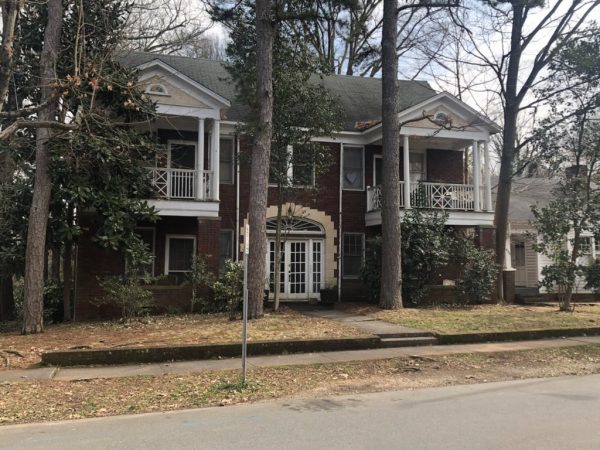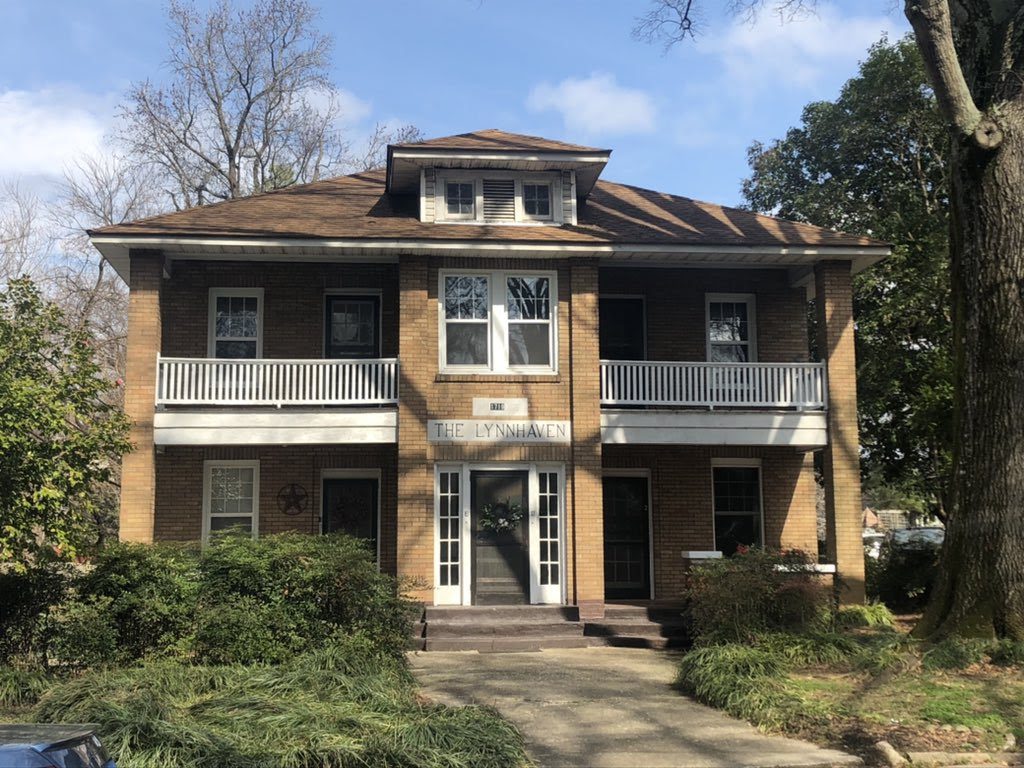The past and future of the Charlotte ‘fourplex’

Down the middle of Hawthorne Lane at the corner of East 8th Street, the dust is just settling on the new LYX Gold Line Extension tracks. When the line opens later this year, it will be the first time a streetcar has rumbled down this block since 1938.
Still, the legacy of that old streetcar era is written all over the Elizabeth neighborhood in the preserved stone-arch shelters and tree-lined sidewalks. The mix of houses, small apartments and the occasional corner restaurant or small line of low-slung brick shops harken back to a time when this neighborhood two miles from Uptown was a suburb, and most shopping trips happened on foot.
“I love the Elizabeth neighborhood,” says Charlotte historian Tom Hanchett. “You can see every possible variation of (multi-family housing) within about a block and a half – at least one two-flat, a few quadraplexes, a duplex.”
It’s a neighborhood environment that fell away in the era of auto-centric development in Sun Belt cities, and one the city of Charlotte is trying to recapture in its long-term comprehensive plan for 2040. The plan, which some City Council members expressed skepticism about in a Mar. 1 meeting, calls for light rail, streetcar, and rapid bus transit lines to knit these neighborhoods together. Expanded housing choices within these neighborhoods will shape who might afford to live there. The plan would allow duplex and triplex houses on all single-family-zoned lots and four-unit buildings on larger, arterial streets that are today zoned exclusively for single-family houses.
Charlotte is not alone in this change. Throughout the country, preservationists and planners, urbanists and affordable housing activists are looking to expand those choices beyond the self-contained, single-family home subdivisions or campus-style apartment complexes that came to dominate American building since the post-World War II suburban boom.
And they’re looking at neighborhoods like Elizabeth — which developed before zoning codes and the Federal Housing Administration’s preference for single-family homes — not only as exemplars of historic preservation but also options for more affordability in an increasingly tight housing market. Not enough units are being built to meet increasing demand from newcomers, 400,000 more of whom are projected to land in the city by 2040.
Smaller-scale multi-family buildings, like the duplexes, fourplexes and eight-unit apartments that cluster around Hawthorne and 7th Street are, proponents say, one part of the solution. These building styles can add more housing units to high-demand neighborhoods increasing the overall supply and offering rental options to people with a variety of income levels.

A typical quadraplex in the Elizabeth neighborhood. Photo: Chuck McShane
But smaller-scale multi-family housing has become the “missing middle,” as zoning regulations and neighborhood opposition have made them more difficult to build. Housing units in 2-4-unit buildings made up about 3.5% of the Charlotte Metro Area’s existing housing stock as of 2019. Last year, municipal governments in the region issued permits for less than 90 units of duplex, triplex, or fourplex housing – less than 0.5% of the 24,225 permits issued. In total, 73% of permits were for single family homes and 26% for apartment buildings, averaging 32.8 units per building.
From around the 1890s through 1930s, growing urban populations required cities to expand outward, and new transit options like the streetcar offered a growing middle class the opportunity to leave crowded city quarters for larger homes with yards within commuting distance of the city. Elizabeth – and other close-in Charlotte neighborhoods like Dilworth, Plaza-Midwood and Wesley Heights – are typical of these “streetcar suburbs” in many American cities, Hanchett says.
While single-family homes were fashionable, proximity to the new transit lines meant lots within walking distance of a streetcar stop were increasingly in demand, and rapid population growth (the city grew by nearly 80% between 1920 and 1930) increased the need for rental units. In a time before guaranteed retirement income, duplexes and fourplexes became small investment properties for nearby homeowners. The 5,700-square-foot duplex at 8th and Lamar was one example of that trend. John Alexander, a prominent developer in the early 1900s, built the duplex in 1922 for his sister, Jennie, who lived in one unit and rented out the other unit until her death in 1932.
“Certificates of deposits, 401ks, mutual funds, none of that stuff existed,” Hanchett says. “So what that duplex did was give her (Alexander) an income stream.”
Each city developed its own vernacular form of small multi-family (triple-deckers in Boston, two-flats in Chicago), and in Charlotte, the two-story quadraplex, or fourplex, with two one-to-two-bedroom units on each floor, complete with a porch or balcony, became the preferred style.
Quadraplexes were less common in historically black neighborhoods, where narrow, one-story shotgun houses predominated. But Hanchett sees similarities in the shotgun style and the fourplex.
“When I look at a quadraplex, I see two shotgun houses stacked on top of each other like cordwood,” Hanchett says.
In middle-class suburbs like Elizabeth and Dilworth, builders added brick siding and other architectural flourishes to fourplexes, like the single-family homes they stood alongside. While neighborhoods in the 1920s and 30s were mixed-used, they weren’t necessarily mixed-status. Racial segregation in housing had hardened during this period and, Hanchett says, and quadraplex tenants were not unlike their neighbors in other aspects.
“The tenants were newlyweds, single people and young families. Occasionally older retired people or traveling salesmen,” Hanchett says. “In terms of social status, they were similar to the folks living in the single-family houses.”
A few policy choices led to the decline in multifamily housing after the 1940s. First, the Federal Housing Administration in the late-1930s offered better rates on loans for single-family homes in majority single-family neighborhoods. Then, the post-WWII GI Bill offered down-payment assistance to millions of returning soldiers, most of whom would wind up in the rapidly rising tract houses in newer suburbs.Citywide zoning, which arrived in Charlotte in 1947, separated most new multifamily construction from single-family areas. Duplexes and fourplexes seemed suddenly outmoded.
“The construction of missing middle housing fell off a cliff once zoning became widespread,” says Emily Hamilton, Senior Research Fellow and Director of the Urbanity Project at George Mason University’s Mercatus Center. “Allowing more missing middle today is a big part of reducing the negative consequences of zoning.”
Zoning is a hyperlocal issue. While cities write zoning codes, exemptions and exceptions are often fought parcel-by-parcel, at the neighborhood level. Still, the cumulative effect of local zoning decisions made single-family zoning dominant throughout the country. In Charlotte, for example, more than 84% of residential land is zoned for single-family construction. Even in famously urban New York City, zoning on 15% of land doesn’t allow for multi-family construction.
Single-family zoning has come under fire from a growing coalition in recent years.
Advocates for greater housing supply and proponents of the YIMBY, or “Yes in My Backyard” movement, say zoning restricts developers from building the type of housing that the market demands. By restricting housing supply, single-family zoning drives up the cost of housing in fast-growing markets. Advocates for affordable housing and racial equity argue that homogenous housing options serve to uphold de facto racial segregation and keep some neighborhoods out of reach for low-to-moderate-income families who might work or attend school in the area.
[Read more: 2020 was supposed to be the ‘year of the plan.’ What happened?]
Minneapolis, for example, ended single-family zoning this year, allowing triplexes on any single-family lot. Oregon pre-empted cities state-wide from allowing single-family zoning. Berkeley, Calif., which pioneered single-family zoning in 1916, voted to phase it out by the end of 2022. Closer to home, Durham, N.C., voted to allow small multi-family and Accessory Dwelling Units (ADUs), such as garage or garden apartments, on current single-family lots near downtown.
In Charlotte, the city’s 2040 Comprehensive Plan, which is expected to come up for a vote with the City Council on April 26, calls for allowing duplexes and triplexes on land currently zoned for single-family housing. That doesn’t mean that single-family homes won’t be built, says City of Charlotte Assistant City Manager and Planning Direct Taiwo Jaiyeoba, just that single-family homes won’t be the only type of construction allowed. The plan calls for a “Neighborhood 1” classification as places with “a variety of housing types, where single-family zoning is still the predominant use.”
Fourplexes and other small multifamily buildings would be allowed on lots facing arterial roads, “when key city priorities are advanced and community benefit is provided such as affordable and/or workforce housing.”
Jaiyeoba says while duplexes and triplexes would be allowed everywhere, the city would channel fourplex construction near existing bus and rail lines, to encourage less car use and reduce potential parking problems.
“You’ve got to make sure that (fourplex residents) don’t have to bear the burden of transportation costs as well,” says Jaiyeoba. “Why do we want to burden them by putting them in a neighborhood where the nearest transportation lines are too far away?”
Zoning is not the only barrier to “missing middle” construction. Deed restrictions, height limits, setbacks, and floor area ratio requirements, which limit the amount of square footage that can be built on a certain parcel of land, can limit triplex and quadraplex construction. For example, a floor area ratio of 0.5 on a 5,000-square-foot lot, would restrict any building to 2,500 square feet, leaving little space for more than a duplex. Floor area requirements, Hamilton says, have limited new triplex construction in Minneapolis, despite the new zoning ordinance. In Houston, by contrast, developers can build vertical townhomes of 3,000 to 4,000 square feet on 1,400 square-foot lots.
“Triplex permitting has been disappointing (in Minneapolis), says Hamilton. “There’s a lot more flexibility under Houston’s regulations.” To encourage more triplex building, Minneapolis has recently relaxed restrictions that would allow new triplexes to take up larger portions of existing lots.
In Charlotte, specifics like floor area ratios and setbacks will be handled in the Unified Development Ordinance scheduled to be adopted this fall. For now, Jaiyeoba says, the task is getting buy-in from neighborhoods skeptical of changes to single-family-zoned lots. Homeowners’ groups in some neighborhoods have offered mostly curiosity and concerns about traffic, though talk on online message boards veered into territory that was “borderline disrespectful.”
“It’s not because people don’t like it,” Jaiyeoba says. “It’s because people don’t understand it. The moment you say, ‘we are changing the zoning,’ it feels like you are losing your neighborhood. When you change the conversation to say, ‘This could be a place where your kid could live. This could be a place that you could move to in retirement,’ I think it takes the edges away.”